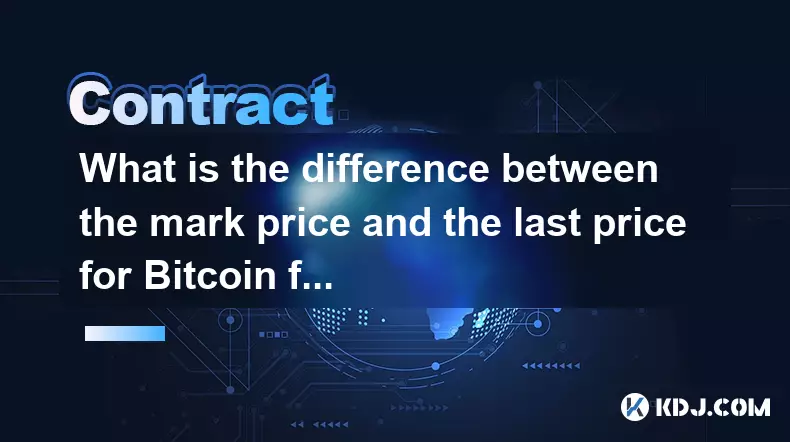-
 bitcoin
bitcoin $122090.672462 USD
1.59% -
 ethereum
ethereum $4493.758974 USD
0.56% -
 xrp
xrp $3.033145 USD
0.65% -
 tether
tether $1.000629 USD
0.00% -
 bnb
bnb $1169.854250 USD
7.07% -
 solana
solana $230.954786 USD
-0.19% -
 usd-coin
usd-coin $0.999785 USD
0.00% -
 dogecoin
dogecoin $0.256108 USD
-1.12% -
 tron
tron $0.342333 USD
-0.12% -
 cardano
cardano $0.859632 USD
-0.10% -
 hyperliquid
hyperliquid $48.932146 USD
-2.25% -
 chainlink
chainlink $22.345466 USD
-1.29% -
 ethena-usde
ethena-usde $1.000217 USD
-0.03% -
 avalanche
avalanche $31.203456 USD
1.93% -
 sui
sui $3.579145 USD
1.05%
What is the difference between the mark price and the last price for Bitcoin futures?
The last price reflects real-time Bitcoin futures trades, while the mark price—based on spot indexes and funding rates—prevents manipulation and ensures fair liquidations.
Oct 02, 2025 at 02:19 am

Understanding Mark Price and Last Price in Bitcoin Futures
1. The last price refers to the most recent transaction price at which a Bitcoin futures contract was traded on an exchange. It reflects actual market activity and shows what buyers and sellers agreed upon in the latest trade. This value updates each time a new trade occurs and is commonly used to track real-time price movements.
2. In contrast, the mark price is not based solely on trading activity. It is a calculated value designed to reflect the fair value of a futures contract. Exchanges derive it using underlying spot prices from major markets, often incorporating data from funding rates and price indexes across multiple exchanges to prevent manipulation.
3. One key function of the mark price is to determine when positions get liquidated. Using only the last price could allow traders to manipulate the market by executing misleading trades near their liquidation levels. The mark price acts as a stabilizing mechanism, reducing the risk of unfair liquidations during periods of low liquidity or high volatility.
4. Funding rates play a significant role in shaping the mark price, especially in perpetual futures contracts. These rates ensure that the futures price converges with the spot price over time. When funding rates are positive, long position holders pay shorts; when negative, the reverse happens. This dynamic influences how the mark price deviates from the last price.
5. Traders monitoring open positions must understand both values. While the last price indicates current market sentiment and execution levels, the mark price determines unrealized profit and loss calculations and margin requirements. Discrepancies between the two can signal market inefficiencies or heightened volatility.
Role of Index-Based Pricing
1. Most cryptocurrency derivatives platforms use an index price composed of spot prices from several reputable exchanges such as Coinbase, Binance, and Kraken. This index forms the foundation of the mark price calculation, ensuring it remains resistant to short-term spikes or anomalies on any single exchange.
2. The mark price is typically computed using the formula: Index Price + Basis, where the basis accounts for expected future convergence between spot and futures values. This method helps maintain alignment between derivative instruments and the actual asset value.
3. During flash crashes or sudden surges, the last price might drop or spike dramatically due to panic selling or aggressive buying. However, the mark price adjusts more gradually because it relies on averaged data. This protects leveraged traders from being prematurely liquidated due to transient price distortions.
4. Arbitrageurs monitor the spread between the last price and the mark price closely. If the futures contract trades significantly above the mark price, they may sell futures and buy spot Bitcoin to capture the difference, helping bring prices back into equilibrium.
5. Exchanges frequently update the mark price—sometimes every few seconds—to ensure accuracy without sacrificing stability. These updates incorporate real-time changes in the underlying index while filtering out noise through smoothing algorithms.
Impact on Leverage and Liquidations
1. High-leverage traders are particularly sensitive to differences between the last price and the mark price. Since liquidations are triggered based on the mark price, a sharp move in the last price may not immediately affect their position if the mark price remains stable.
2. For example, if the last price suddenly drops due to a large market sell order but the broader spot index stays relatively unchanged, the mark price will not follow the dip instantly. This delay gives traders breathing room before potential liquidation.
3. Conversely, prolonged divergence between the last price and the mark price can indicate strong directional pressure. If futures consistently trade above the mark price, it suggests bullish momentum and possible upward pressure on the spot market once arbitrage kicks in.
4. Risk engines within trading platforms rely heavily on the mark price when calculating maintenance margins. Even if a trader’s position appears safe based on the last price, the system evaluates equity using the mark price to determine whether margin calls should be issued.
5. Some advanced trading interfaces display both prices simultaneously, along with visual indicators showing the spread. Savvy traders use this information to time entries and exits, avoiding execution during moments of extreme dislocation.
Frequently Asked Questions
Why do some exchanges show different mark prices?Exchanges calculate the mark price using slightly different methodologies, including variations in the spot index composition, weighting mechanisms, and smoothing techniques. Differences in included exchanges or data frequency can lead to minor discrepancies in the final value.
Can the last price stay disconnected from the mark price indefinitely?No. Market forces such as arbitrage ensure that sustained deviations are corrected. Traders exploiting price gaps between futures and spot markets act quickly, restoring equilibrium. Long-term divergence contradicts the principle of price convergence in efficient markets.
Is the mark price used for all types of futures contracts?Yes. Whether it's quarterly futures or perpetual swaps, the mark price serves as a reference for valuation and risk management. Its importance increases in perpetual contracts due to continuous funding mechanisms and higher leverage exposure.
How does funding rate affect the relationship between mark and last price?Funding rates adjust the mark price to reflect demand imbalances between long and short positions. High positive funding signals excessive long interest, pushing the mark price higher relative to the spot index. This influences how close the last price needs to be to trigger liquidations.
Disclaimer:info@kdj.com
The information provided is not trading advice. kdj.com does not assume any responsibility for any investments made based on the information provided in this article. Cryptocurrencies are highly volatile and it is highly recommended that you invest with caution after thorough research!
If you believe that the content used on this website infringes your copyright, please contact us immediately (info@kdj.com) and we will delete it promptly.
- BlockDAG, DOGE, HYPE Sponsorship: Crypto Trends Shaping 2025
- 2025-10-01 00:25:13
- Deutsche Börse and Circle: A StableCoin Adoption Powerhouse in Europe
- 2025-10-01 00:25:13
- BlockDAG's Presale Buzz: Is It the Crypto to Watch in October 2025?
- 2025-10-01 00:30:13
- Bitcoin, Crypto, and IQ: When Genius Meets Digital Gold?
- 2025-10-01 00:30:13
- Stablecoins, American Innovation, and Wallet Tokens: The Next Frontier
- 2025-10-01 00:35:12
- NBU, Coins, and Crypto in Ukraine: A New Yorker's Take
- 2025-10-01 00:45:14
Related knowledge

What is the difference between futures and perpetual contracts for Bitcoin?
Oct 02,2025 at 11:54pm
Understanding Bitcoin Futures Contracts1. Bitcoin futures are derivative instruments that allow traders to speculate on the future price of Bitcoin at...

What is the best time to trade PEPE contracts?
Oct 03,2025 at 11:54am
Understanding PEPE Contract Volatility1. PEPE contracts exhibit extreme price fluctuations due to their meme-based nature and low market cap. Trading ...

What are the common mistakes to avoid with Bitcoincoin contracts?
Oct 03,2025 at 08:54am
Emerging Trends in the Cryptocurrency Market1. Decentralized finance (DeFi) platforms continue to expand their influence across the blockchain ecosyst...

What is the maintenance margin for Bitcoin contracts?
Oct 02,2025 at 01:36am
Decentralized Exchanges Gain Momentum in 20241. Decentralized exchanges (DEXs) have seen a significant rise in trading volume, surpassing centralized ...

How to use technical analysis for trading XRP contracts?
Oct 03,2025 at 01:18pm
Understanding Price Patterns in XRP Futures1. Identifying chart patterns such as triangles, head and shoulders, and double tops or bottoms can provide...

What does "longing" PEPE contracts mean?
Oct 03,2025 at 11:54pm
Understanding Decentralized Exchanges in the Crypto Ecosystem1. Decentralized exchanges (DEXs) operate without a central authority, allowing users to ...

What is the difference between futures and perpetual contracts for Bitcoin?
Oct 02,2025 at 11:54pm
Understanding Bitcoin Futures Contracts1. Bitcoin futures are derivative instruments that allow traders to speculate on the future price of Bitcoin at...

What is the best time to trade PEPE contracts?
Oct 03,2025 at 11:54am
Understanding PEPE Contract Volatility1. PEPE contracts exhibit extreme price fluctuations due to their meme-based nature and low market cap. Trading ...

What are the common mistakes to avoid with Bitcoincoin contracts?
Oct 03,2025 at 08:54am
Emerging Trends in the Cryptocurrency Market1. Decentralized finance (DeFi) platforms continue to expand their influence across the blockchain ecosyst...

What is the maintenance margin for Bitcoin contracts?
Oct 02,2025 at 01:36am
Decentralized Exchanges Gain Momentum in 20241. Decentralized exchanges (DEXs) have seen a significant rise in trading volume, surpassing centralized ...

How to use technical analysis for trading XRP contracts?
Oct 03,2025 at 01:18pm
Understanding Price Patterns in XRP Futures1. Identifying chart patterns such as triangles, head and shoulders, and double tops or bottoms can provide...

What does "longing" PEPE contracts mean?
Oct 03,2025 at 11:54pm
Understanding Decentralized Exchanges in the Crypto Ecosystem1. Decentralized exchanges (DEXs) operate without a central authority, allowing users to ...
See all articles










































































